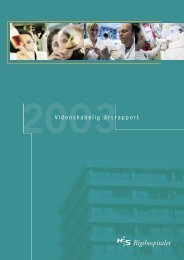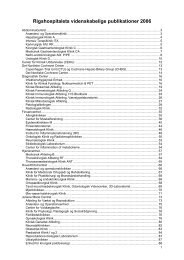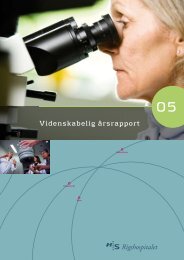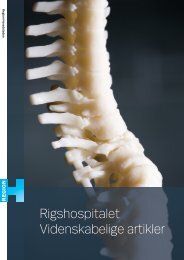View - CTU
View - CTU
View - CTU
Create successful ePaper yourself
Turn your PDF publications into a flip-book with our unique Google optimized e-Paper software.
Reasons for root canal treatment Bj¢rndal et al.<br />
nonvital pulps in significantly more visits than males<br />
(Bjmndal & Reit 2005c).<br />
Conclusions<br />
The present study has found that root canal treatment<br />
in Denmark was still most often associated with caries<br />
and pulpitis. Treatment was typically instituted in vital<br />
molar teeth. Even though apical periodontitis is<br />
frequent in root filled teeth, retreatments were rare.<br />
From a subjective point of view, root canal treatment<br />
was not evaluated as 'very difficult' and was carried out<br />
rapidly.<br />
Aclmowledgements<br />
The GDPs are gratefully acknowledged for their<br />
contribution to the present study. Professor Niels<br />
Keiding, Department of Biostatistics, University of<br />
Copenhagen is kindly acknowledged for his critical<br />
review of the paper. Line Conradsen and Lisbeth<br />
Carstensen are aclmowledged for running the statistical<br />
analyses, This research was financially supported<br />
by Danish Regions.<br />
References<br />
Basmadjian-Charles C, Bourgeois D, Coudeville L, Lebrun T<br />
(2004) National survey of endodontics in general dental<br />
practice in France. Tlie European Journal of Prostlwdontics and<br />
Restorative Dentistry 12, 144-53.<br />
Bjorndal L, Kidd EAM (2005) The treatment of deep dentine<br />
caries lesions. Dental Update 32, 402-13.<br />
Bjorndal L, Reit C (2004) The annual frequency of root fillings,<br />
tooth extractions and pulp-related procedures in Danish<br />
adults during 1977-2003. International Endodontic Journal<br />
37, 782-8.<br />
Bjorndal L, Reit C (2005a) The CAP-1 trial: stepwise excavation<br />
versus one completed excavation in deep caries [WWW document].<br />
URL http:/ I clinicaltrials.gov I ct/ show /NCTOO 18 7 8 3 71<br />
order=l [accessed on 7 November 2005].<br />
Bjorndal L, Reit C (2005b) The CAP-2 triaL· effect of direct pulp<br />
capping versus partial pulpotomi [WWW document]. URL<br />
http://clinicaltrials.gov/ ct/show/NCTOOl 8 78 5 O?order=8<br />
[accessed on 7 November 2005].<br />
Bjorndal L, Reit C (2005c) The adoption of new endodontic<br />
technology amongst Danish general dental practitioners.<br />
International Endodontics Journal 38, 52-8.<br />
Dugas NN, Lawrence HP, Teplitsky PE, Pharoah MJ, Friedman<br />
S (2003) Periapical health and treatment quality assessment<br />
of root-filled teeth in two Canadian populations.<br />
International Endodontic Journal 36, 181-92.<br />
Eriksen HM, Kirkevang L-L, Petersson K (2002) Endodontic<br />
epidemiology and treatment outcome: general considerations.<br />
Endodontic Topics 2, 1-9.<br />
Jenkins SM, Hayes SJ, Dummer PMH (2001) A study of<br />
endodontic treatment carried out in dental practice within<br />
the UK. International Endodontic Journal 34, 16-22.<br />
Karlsson P-0, Reit C (1994) Reasons for endodontic treatment<br />
among Swedish general practitioners. (ESE abstract). Intanational<br />
Endodontic Journal 27, 100.<br />
Kirkevang L-L, Hilrsted-Bindslev P, 0rstavik D, Wenzel A<br />
(2001) A comparison of the quality of root canal treatment<br />
in two Danish subpopulations examined 1974-75 and<br />
1997-98. International Endodontic Journal 34, 607-12.<br />
Kreiner S (2003) Introduction to DIGRAM. University of<br />
Copenhagen: depm·tment of biostatistics [WWW document].<br />
URL http://www.biostat.ku.dk/ ~skm/skm/index.html.<br />
Kvist T, Heden G, Reit C (2004) Endodontic retreatment<br />
strategies used by general dental practitioners. Oral Surgery<br />
Oral Medicine Oral Pathology Oral Radiology Endodontics 97,<br />
502-7.<br />
Marthaler TM (2004) Changes in Dental caries 1953-2003.<br />
Caries Researc/1 38, 173-81.<br />
McColl E, Smith M, Whitworth J, Seccombe G, Steele J (1999)<br />
Barriers to improving endodontic care: the views of NHS<br />
practitioners. British Dental Journal 186, 564-8.<br />
Parashos P, Messer HH (2004) Questionnaire survey on the<br />
use of rotary nickel-titanium instruments by Australian<br />
dentists. International Endodontic Journal 37, 249-59.<br />
Petersen PE, Kjoller M, Christensen LB, Krustrup U (2003)<br />
Voksenbefolkningens tandstatus og udnyttelse af tandplejetilbuddet<br />
i Danmark 2000. Tandlaegebladet 107, 6 72-84.<br />
Poulsen S, Malling Pedersen M (2002) Dental caries in Danish<br />
children: 1988-2001. European Journal of Peadiatric Dentistry<br />
4, 195-8.<br />
Reit C, Heden G, Milthon R (1993) Endodontiskt behandlingspanorama<br />
inom allmiintandvarden. Tandliikartidningen 85,<br />
543-6.<br />
Saunders WP, Chestnutt IG, Saunders EM (1999a) Factors<br />
influencing the diagnosis and management of teeth with<br />
pulpal and periradicular disease by general dental practitioners.<br />
Part 1. British Dental Journal 187, 492-7.<br />
Saunders WP, Chestnutt !G, Saunders EM (1999b) Factors<br />
influencing the diagnosis and management of teeth with<br />
pulpal and periradicular disease by general dental practitioners.<br />
Part 2. British Dental Journal 187, 548-54.<br />
Slaus G, Bottenberg P (2002) A survey of endodontic practice<br />
amongst Flemish dentists. International Endodontic Journal<br />
35, 759-67.<br />
Tan RT, Burke FJT (199 7) Response rates to questionnaires<br />
mailed to dentists. A review of 77 publications. International<br />
Dental Journal 47, 349-54.<br />
Upton G (1999) Goodman-Kruskal measures of association.<br />
In: Armitage P, Colton T, eds. Encyclopedia of Biostatistics,<br />
Vol. 2. Weinheim, Germany: WILEY-VCR, pp. 172.<br />
Bj0rndal L, Rei<br />
Dige I, Nyvad E<br />
EM, Wennstror<br />
adults: randomi<br />
and direct pulp<br />
118, 290-7.<br />
Reprinted with per<br />
International Endodontic Journal, 39, 785-790, 2006<br />
© 2006 International Endodontic Journal








